maintenance schedule FORD F750 2013 12.G Owner's Manual
[x] Cancel search | Manufacturer: FORD, Model Year: 2013, Model line: F750, Model: FORD F750 2013 12.GPages: 378, PDF Size: 3.82 MB
Page 232 of 378
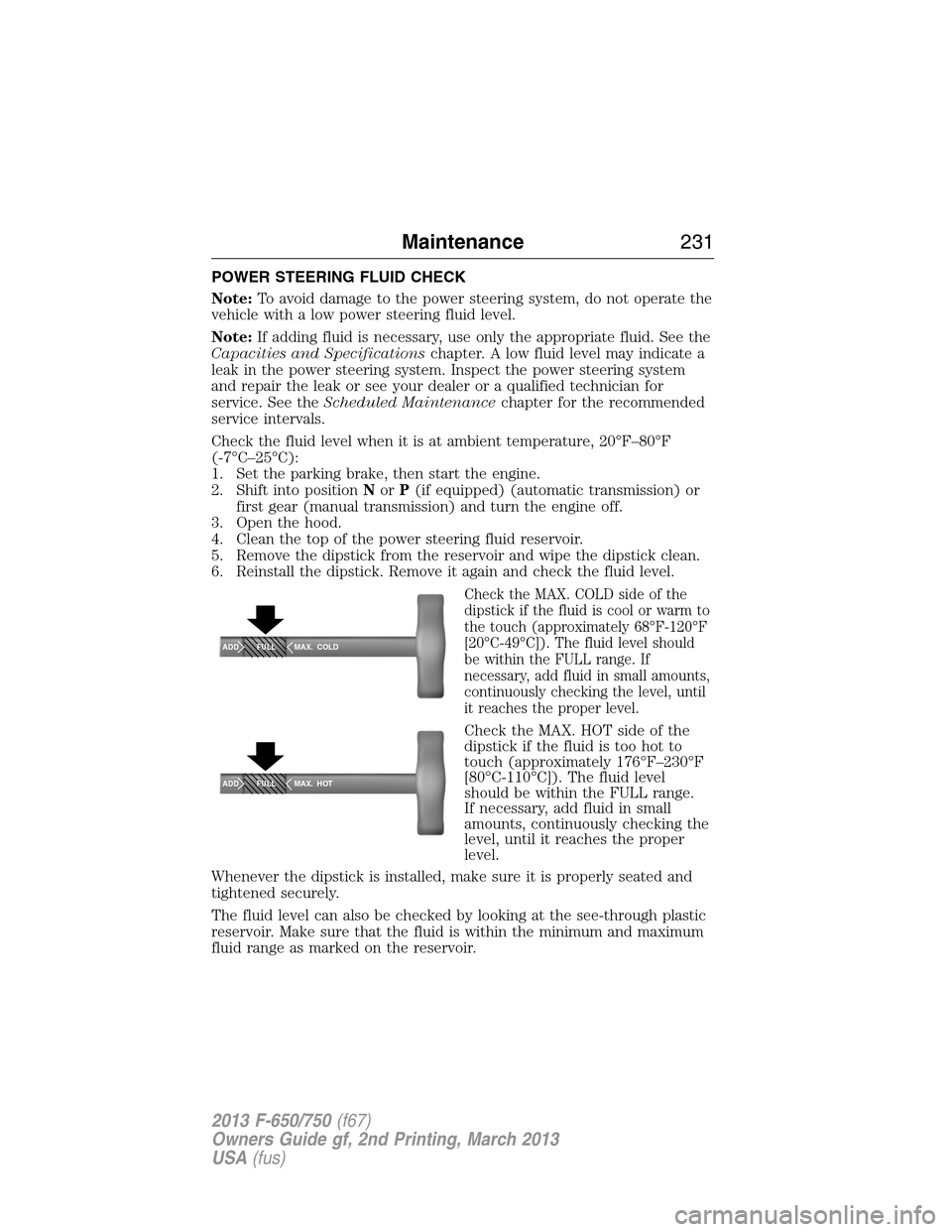
POWER STEERING FLUID CHECK
Note:To avoid damage to the power steering system, do not operate the
vehicle with a low power steering fluid level.
Note:If adding fluid is necessary, use only the appropriate fluid. See the
Capacities and Specificationschapter. A low fluid level may indicate a
leak in the power steering system. Inspect the power steering system
and repair the leak or see your dealer or a qualified technician for
service. See theScheduled Maintenancechapter for the recommended
service intervals.
Check the fluid level when it is at ambient temperature, 20°F–80°F
(-7°C–25°C):
1. Set the parking brake, then start the engine.
2. Shift into positionNorP(if equipped) (automatic transmission) or
first gear (manual transmission) and turn the engine off.
3. Open the hood.
4. Clean the top of the power steering fluid reservoir.
5. Remove the dipstick from the reservoir and wipe the dipstick clean.
6. Reinstall the dipstick. Remove it again and check the fluid level.
Check the MAX. COLD side of the
dipstick if the fluid is cool or warm to
the touch (approximately 68°F-120°F
[20°C-49°C]). The fluid level should
be within the FULL range. If
necessary, add fluid in small amounts,
continuously checking the level, until
it reaches the proper level.
Check the MAX. HOT side of the
dipstick if the fluid is too hot to
touch (approximately 176°F–230°F
[80°C-110°C]). The fluid level
should be within the FULL range.
If necessary, add fluid in small
amounts, continuously checking the
level, until it reaches the proper
level.
Whenever the dipstick is installed, make sure it is properly seated and
tightened securely.
The fluid level can also be checked by looking at the see-through plastic
reservoir. Make sure that the fluid is within the minimum and maximum
fluid range as marked on the reservoir.
ADD MAX. COLD
FULL
ADD MAX. HOT
FULL
Maintenance231
2013 F-650/750(f67)
Owners Guide gf, 2nd Printing, March 2013
USA(fus)
Page 238 of 378
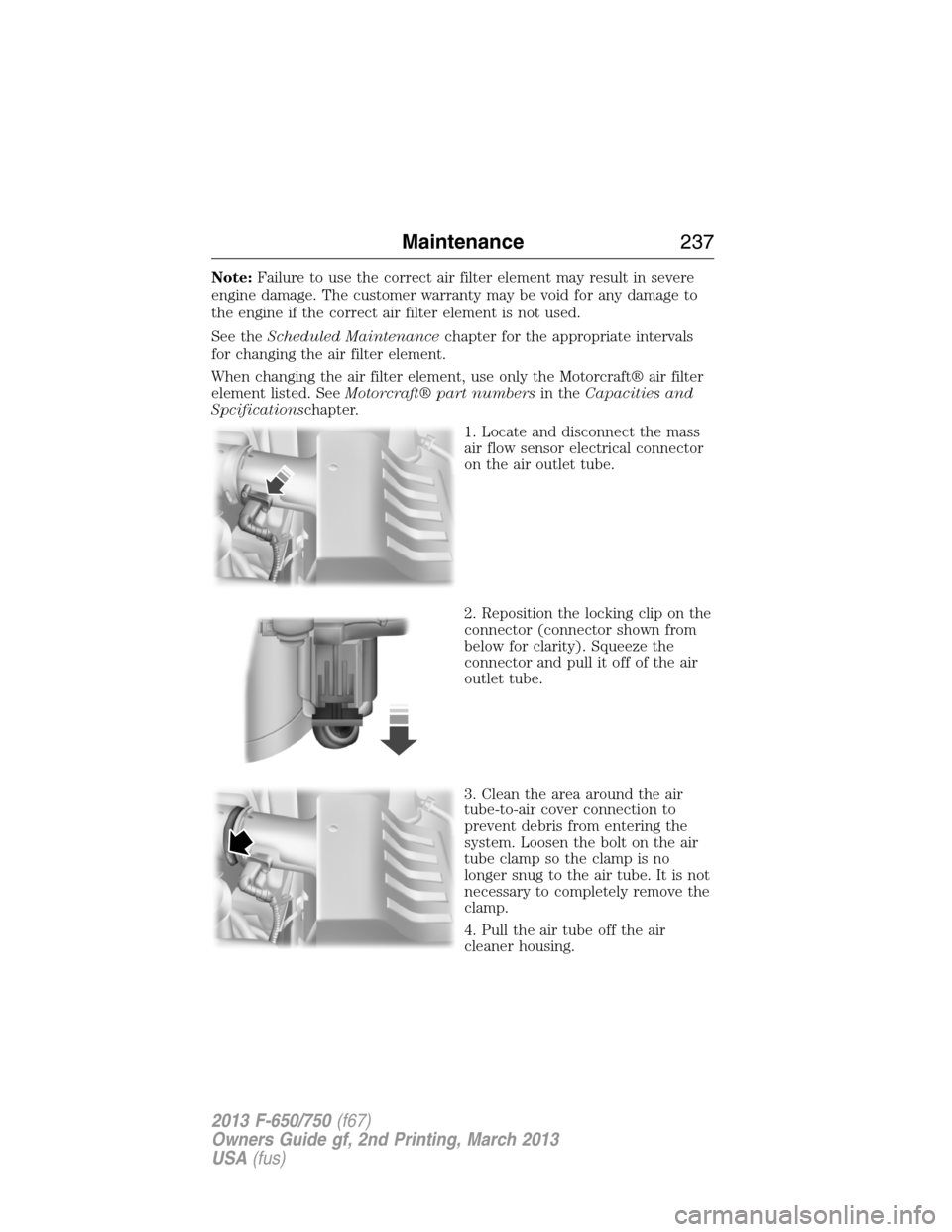
Note:Failure to use the correct air filter element may result in severe
engine damage. The customer warranty may be void for any damage to
the engine if the correct air filter element is not used.
See theScheduled Maintenancechapter for the appropriate intervals
for changing the air filter element.
When changing the air filter element, use only the Motorcraft® air filter
element listed. SeeMotorcraft® part numbersin theCapacities and
Spcificationschapter.
1. Locate and disconnect the mass
air flow sensor electrical connector
on the air outlet tube.
2. Reposition the locking clip on the
connector (connector shown from
below for clarity). Squeeze the
connector and pull it off of the air
outlet tube.
3. Clean the area around the air
tube-to-air cover connection to
prevent debris from entering the
system. Loosen the bolt on the air
tube clamp so the clamp is no
longer snug to the air tube. It is not
necessary to completely remove the
clamp.
4. Pull the air tube off the air
cleaner housing.
Maintenance237
2013 F-650/750(f67)
Owners Guide gf, 2nd Printing, March 2013
USA(fus)
Page 281 of 378
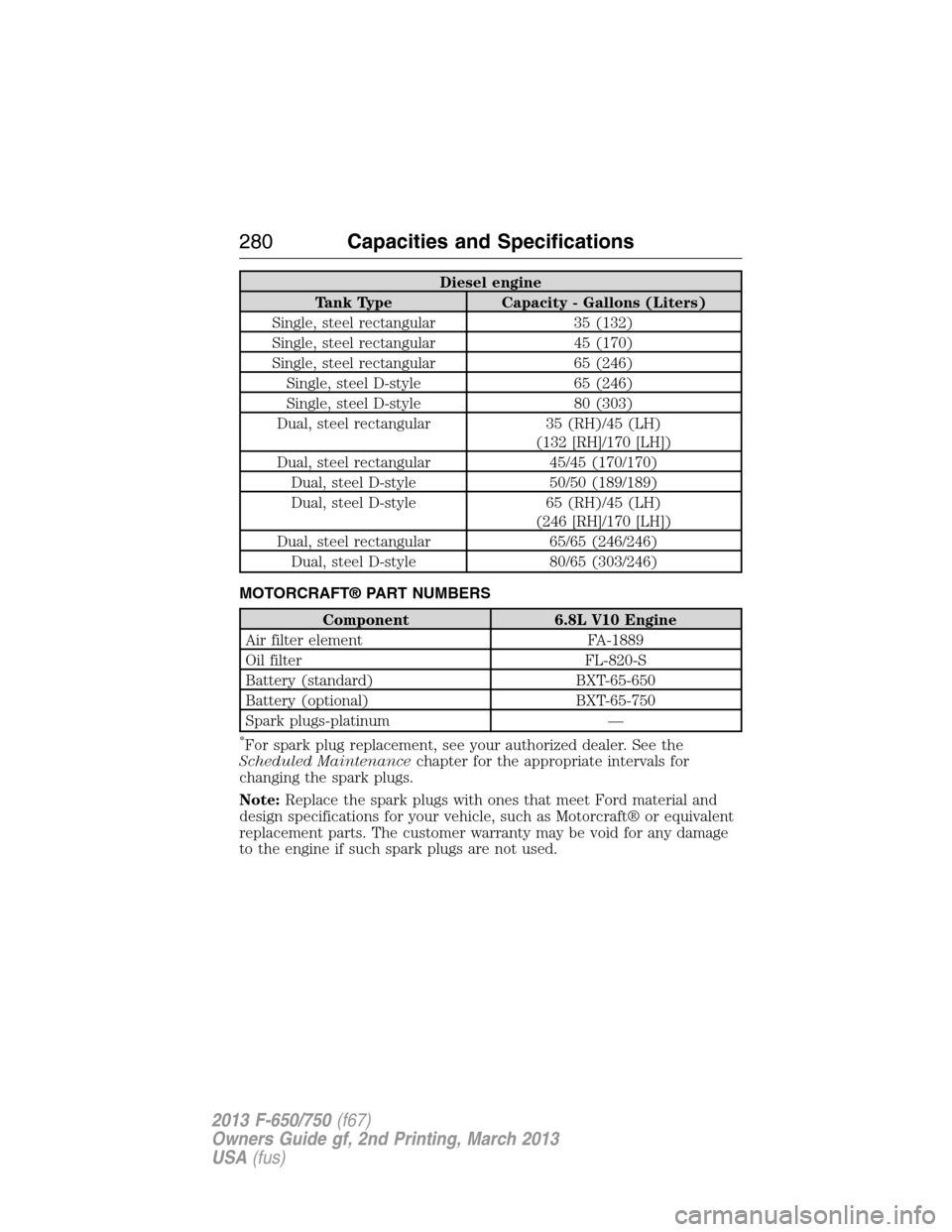
Diesel engine
Tank Type Capacity - Gallons (Liters)
Single, steel rectangular 35 (132)
Single, steel rectangular 45 (170)
Single, steel rectangular 65 (246)
Single, steel D-style 65 (246)
Single, steel D-style 80 (303)
Dual, steel rectangular 35 (RH)/45 (LH)
(132 [RH]/170 [LH])
Dual, steel rectangular 45/45 (170/170)
Dual, steel D-style 50/50 (189/189)
Dual, steel D-style 65 (RH)/45 (LH)
(246 [RH]/170 [LH])
Dual, steel rectangular 65/65 (246/246)
Dual, steel D-style 80/65 (303/246)
MOTORCRAFT® PART NUMBERS
Component 6.8L V10 Engine
Air filter element FA-1889
Oil filter FL-820-S
Battery (standard) BXT-65-650
Battery (optional) BXT-65-750
Spark plugs-platinum —
*For spark plug replacement, see your authorized dealer. See the
Scheduled Maintenancechapter for the appropriate intervals for
changing the spark plugs.
Note:Replace the spark plugs with ones that meet Ford material and
design specifications for your vehicle, such as Motorcraft® or equivalent
replacement parts. The customer warranty may be void for any damage
to the engine if such spark plugs are not used.
280Capacities and Specifications
2013 F-650/750(f67)
Owners Guide gf, 2nd Printing, March 2013
USA(fus)
Page 284 of 378
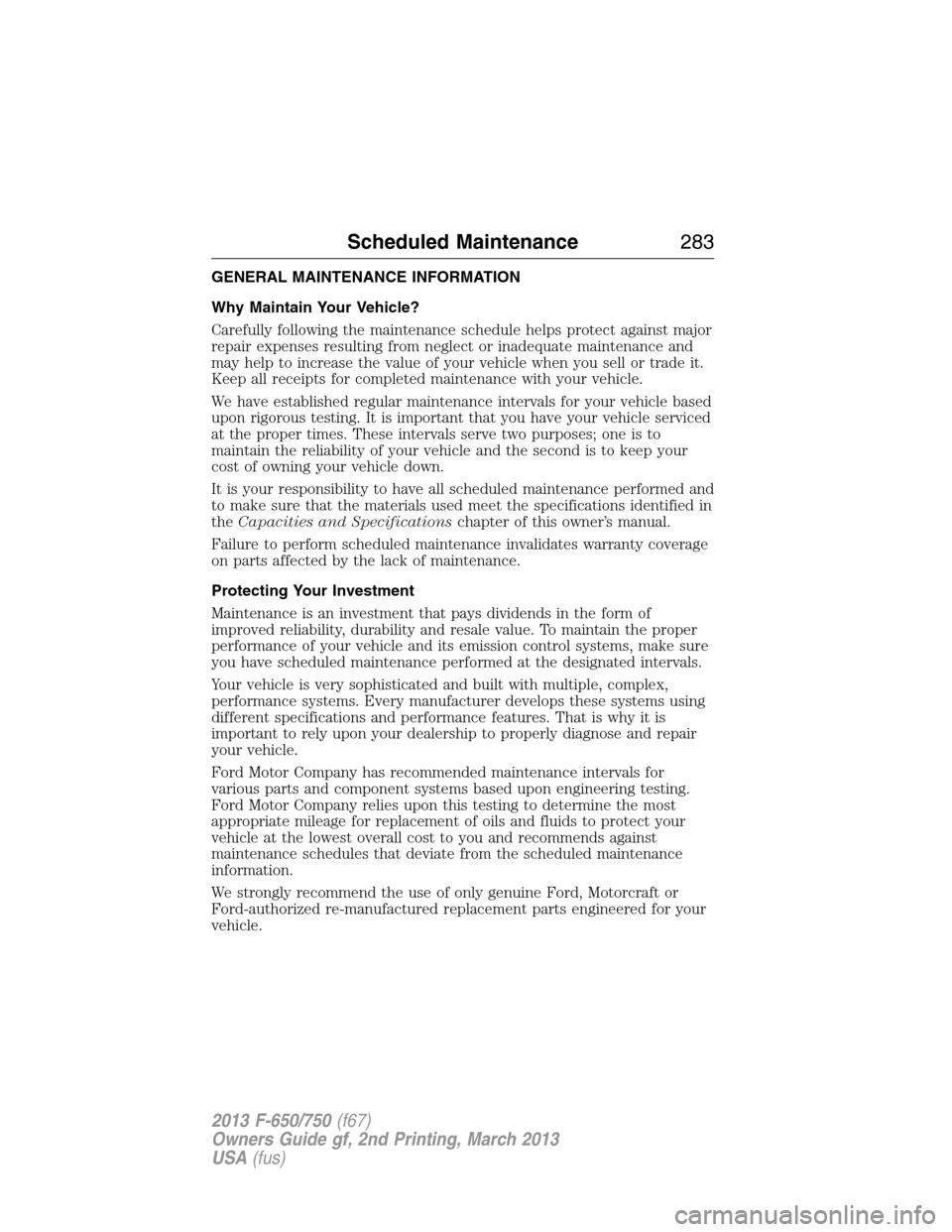
GENERAL MAINTENANCE INFORMATION
Why Maintain Your Vehicle?
Carefully following the maintenance schedule helps protect against major
repair expenses resulting from neglect or inadequate maintenance and
may help to increase the value of your vehicle when you sell or trade it.
Keep all receipts for completed maintenance with your vehicle.
We have established regular maintenance intervals for your vehicle based
upon rigorous testing. It is important that you have your vehicle serviced
at the proper times. These intervals serve two purposes; one is to
maintain the reliability of your vehicle and the second is to keep your
cost of owning your vehicle down.
It is your responsibility to have all scheduled maintenance performed and
to make sure that the materials used meet the specifications identified in
theCapacities and Specificationschapter of this owner’s manual.
Failure to perform scheduled maintenance invalidates warranty coverage
on parts affected by the lack of maintenance.
Protecting Your Investment
Maintenance is an investment that pays dividends in the form of
improved reliability, durability and resale value. To maintain the proper
performance of your vehicle and its emission control systems, make sure
you have scheduled maintenance performed at the designated intervals.
Your vehicle is very sophisticated and built with multiple, complex,
performance systems. Every manufacturer develops these systems using
different specifications and performance features. That is why it is
important to rely upon your dealership to properly diagnose and repair
your vehicle.
Ford Motor Company has recommended maintenance intervals for
various parts and component systems based upon engineering testing.
Ford Motor Company relies upon this testing to determine the most
appropriate mileage for replacement of oils and fluids to protect your
vehicle at the lowest overall cost to you and recommends against
maintenance schedules that deviate from the scheduled maintenance
information.
We strongly recommend the use of only genuine Ford, Motorcraft or
Ford-authorized re-manufactured replacement parts engineered for your
vehicle.
Scheduled Maintenance283
2013 F-650/750(f67)
Owners Guide gf, 2nd Printing, March 2013
USA(fus)
Page 285 of 378
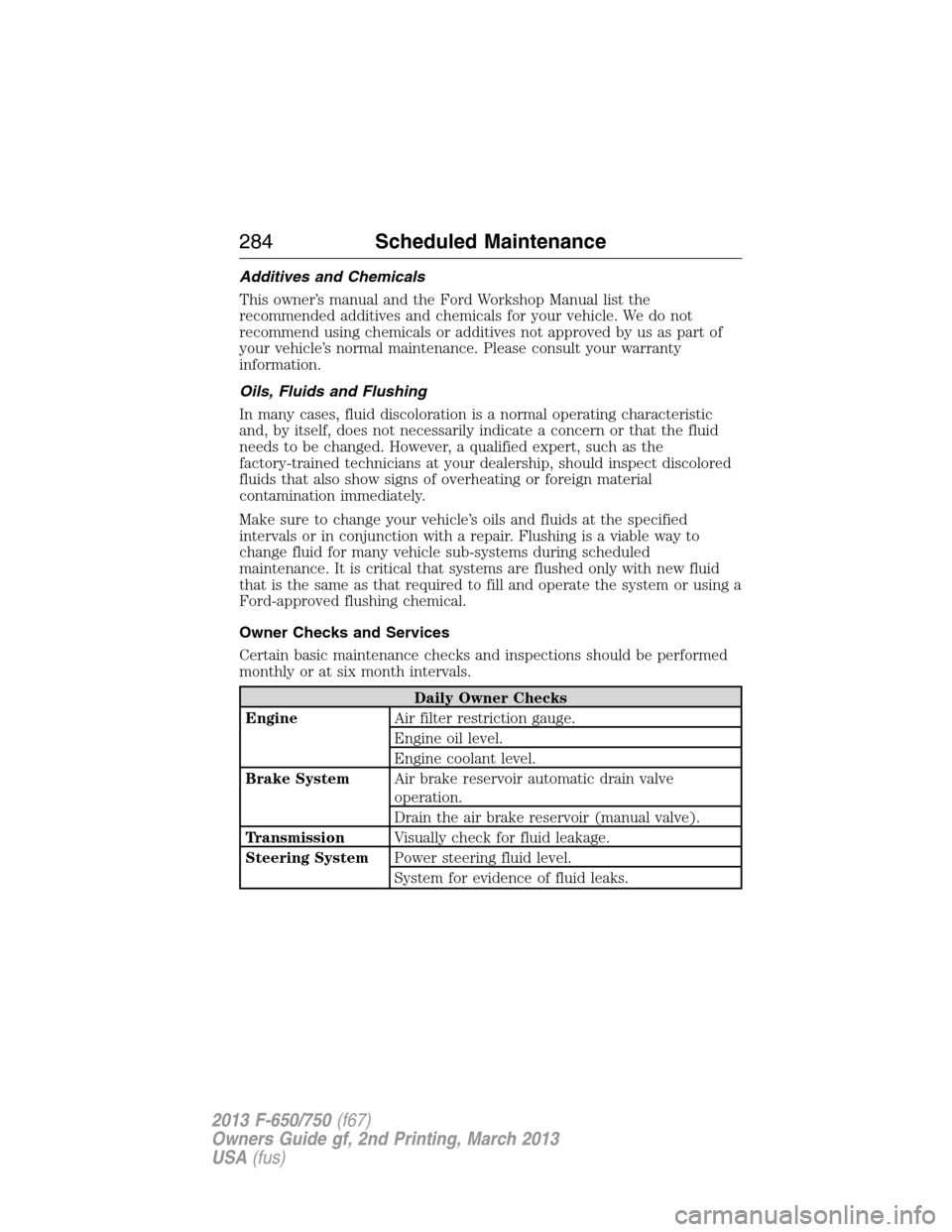
Additives and Chemicals
This owner’s manual and the Ford Workshop Manual list the
recommended additives and chemicals for your vehicle. We do not
recommend using chemicals or additives not approved by us as part of
your vehicle’s normal maintenance. Please consult your warranty
information.
Oils, Fluids and Flushing
In many cases, fluid discoloration is a normal operating characteristic
and, by itself, does not necessarily indicate a concern or that the fluid
needs to be changed. However, a qualified expert, such as the
factory-trained technicians at your dealership, should inspect discolored
fluids that also show signs of overheating or foreign material
contamination immediately.
Make sure to change your vehicle’s oils and fluids at the specified
intervals or in conjunction with a repair. Flushing is a viable way to
change fluid for many vehicle sub-systems during scheduled
maintenance. It is critical that systems are flushed only with new fluid
that is the same as that required to fill and operate the system or using a
Ford-approved flushing chemical.
Owner Checks and Services
Certain basic maintenance checks and inspections should be performed
monthly or at six month intervals.
Daily Owner Checks
EngineAir filter restriction gauge.
Engine oil level.
Engine coolant level.
Brake SystemAir brake reservoir automatic drain valve
operation.
Drain the air brake reservoir (manual valve).
TransmissionVisually check for fluid leakage.
Steering SystemPower steering fluid level.
System for evidence of fluid leaks.
284Scheduled Maintenance
2013 F-650/750(f67)
Owners Guide gf, 2nd Printing, March 2013
USA(fus)
Page 286 of 378
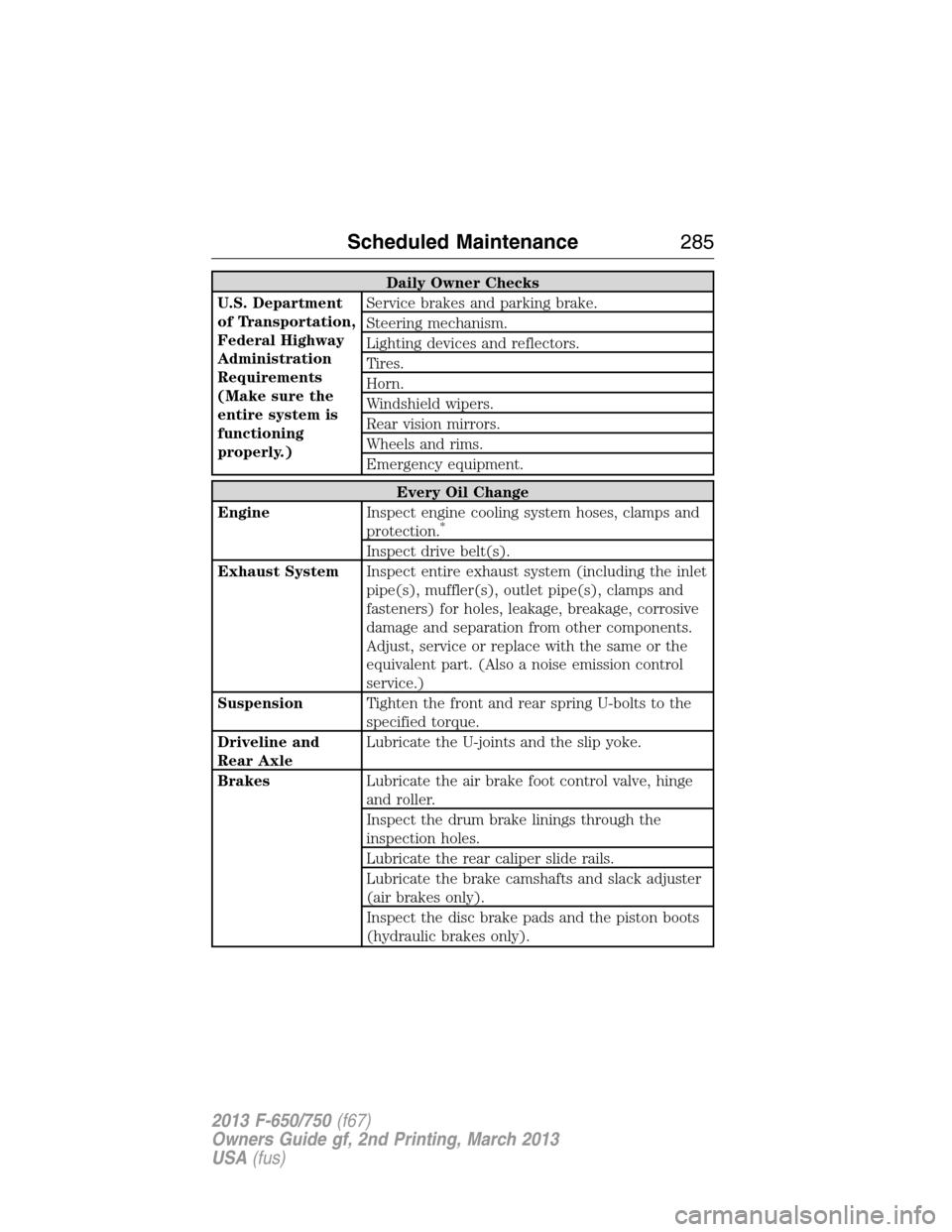
Daily Owner Checks
U.S. Department
of Transportation,
Federal Highway
Administration
Requirements
(Make sure the
entire system is
functioning
properly.)Service brakes and parking brake.
Steering mechanism.
Lighting devices and reflectors.
Tires.
Horn.
Windshield wipers.
Rear vision mirrors.
Wheels and rims.
Emergency equipment.
Every Oil Change
EngineInspect engine cooling system hoses, clamps and
protection.
*
Inspect drive belt(s).
Exhaust SystemInspect entire exhaust system (including the inlet
pipe(s), muffler(s), outlet pipe(s), clamps and
fasteners) for holes, leakage, breakage, corrosive
damage and separation from other components.
Adjust, service or replace with the same or the
equivalent part. (Also a noise emission control
service.)
SuspensionTighten the front and rear spring U-bolts to the
specified torque.
Driveline and
Rear AxleLubricate the U-joints and the slip yoke.
BrakesLubricate the air brake foot control valve, hinge
and roller.
Inspect the drum brake linings through the
inspection holes.
Lubricate the rear caliper slide rails.
Lubricate the brake camshafts and slack adjuster
(air brakes only).
Inspect the disc brake pads and the piston boots
(hydraulic brakes only).
Scheduled Maintenance285
2013 F-650/750(f67)
Owners Guide gf, 2nd Printing, March 2013
USA(fus)
Page 287 of 378
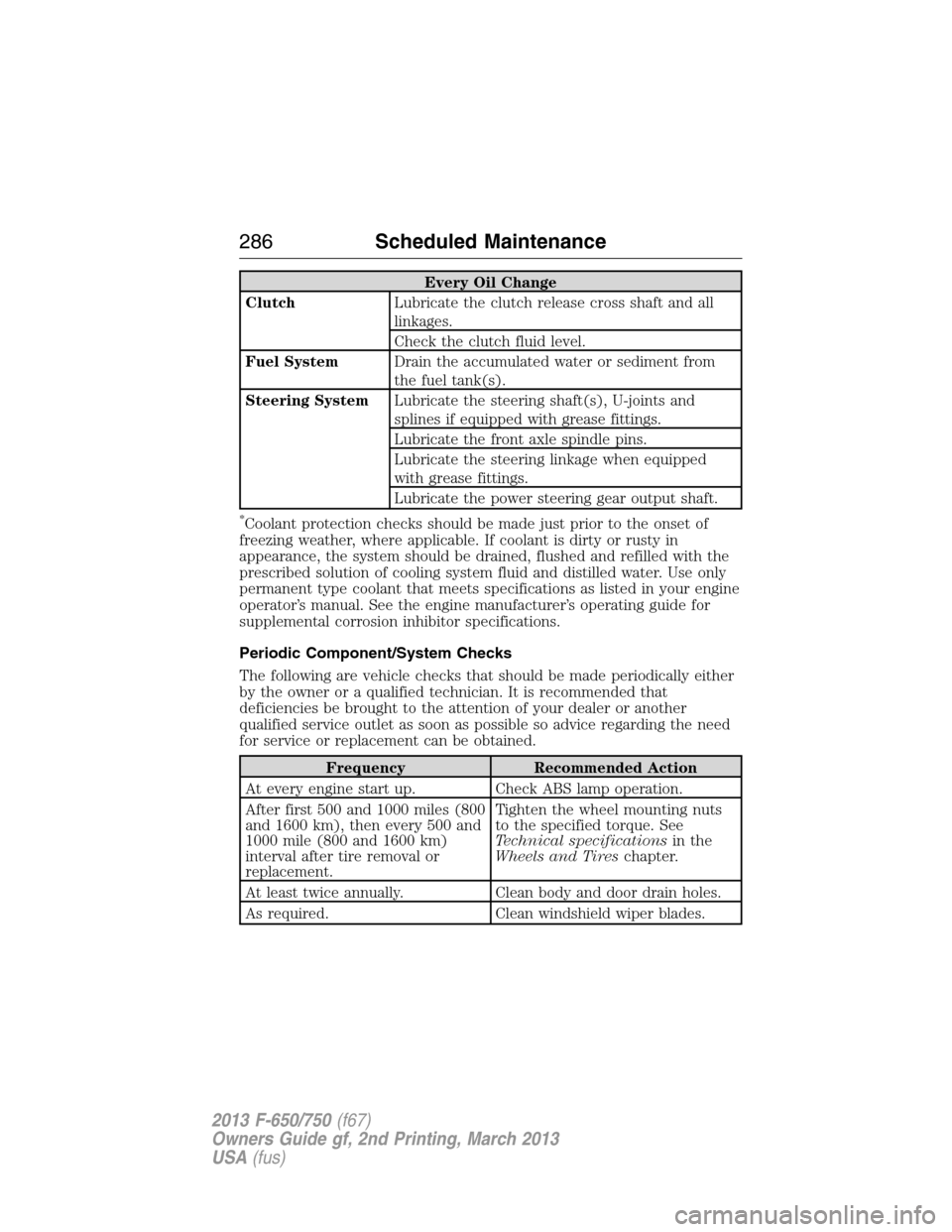
Every Oil Change
ClutchLubricate the clutch release cross shaft and all
linkages.
Check the clutch fluid level.
Fuel SystemDrain the accumulated water or sediment from
the fuel tank(s).
Steering SystemLubricate the steering shaft(s), U-joints and
splines if equipped with grease fittings.
Lubricate the front axle spindle pins.
Lubricate the steering linkage when equipped
with grease fittings.
Lubricate the power steering gear output shaft.
*Coolant protection checks should be made just prior to the onset of
freezing weather, where applicable. If coolant is dirty or rusty in
appearance, the system should be drained, flushed and refilled with the
prescribed solution of cooling system fluid and distilled water. Use only
permanent type coolant that meets specifications as listed in your engine
operator’s manual. See the engine manufacturer’s operating guide for
supplemental corrosion inhibitor specifications.
Periodic Component/System Checks
The following are vehicle checks that should be made periodically either
by the owner or a qualified technician. It is recommended that
deficiencies be brought to the attention of your dealer or another
qualified service outlet as soon as possible so advice regarding the need
for service or replacement can be obtained.
Frequency Recommended Action
At every engine start up. Check ABS lamp operation.
After first 500 and 1000 miles (800
and 1600 km), then every 500 and
1000 mile (800 and 1600 km)
interval after tire removal or
replacement.Tighten the wheel mounting nuts
to the specified torque. See
Technical specificationsin the
Wheels and Tireschapter.
At least twice annually. Clean body and door drain holes.
As required. Clean windshield wiper blades.
286Scheduled Maintenance
2013 F-650/750(f67)
Owners Guide gf, 2nd Printing, March 2013
USA(fus)
Page 288 of 378

Observation Maintenance Operation
Insufficient power shown in loaded
practice stop.Inspect the automatic slack
adjuster function.
Subpar vehicle handling qualities. Check the operation of the brakes,
clutch and steering.
1,2
Excessive noise from under the
cab or engine compartment.Inspect the vehicle for missing,
damaged or mislocated noise
shields.
Excessive engine noise. Check the engine performance and
the engine governor.
Engine overheats; excessive fan
noise; fan constantly runs at high
speed or wobbles due to worn
bearings.Inspect the fan, fan shroud and fan
clutch.
Excessive exhaust noise; smell of
exhaust fumes is experienced.Inspect the entire exhaust system
for holes, leaks, breakage,
looseness and corrosive damage.
Excessive engine compartment
noise.Inspect the engine air induction
system (including air ducts and air
filter) for loose, damaged or
missing components.
Poor steering; wandering;
excessive tire wear.Check front end alignment, inspect
the tires and tire pressure.
3
Vibration or abnormal tire wear
indicating imbalance.Balance the wheels and the tires.
Hard shifting or excessive
vibration.Check the transmission and engine
mountings.
2
High effort to shift; noisy
transmission.Check and adjust transmission
controls.2
Insufficient full-throttle power;
backfiring.Check fuel pump pressure.
Radiator cap does not hold
pressure.Clean the cap seal and cap surface
on the radiator.
Electrical power supply has
diminished.Check the battery terminals for
corrosion.
Scheduled Maintenance287
2013 F-650/750(f67)
Owners Guide gf, 2nd Printing, March 2013
USA(fus)
Page 289 of 378
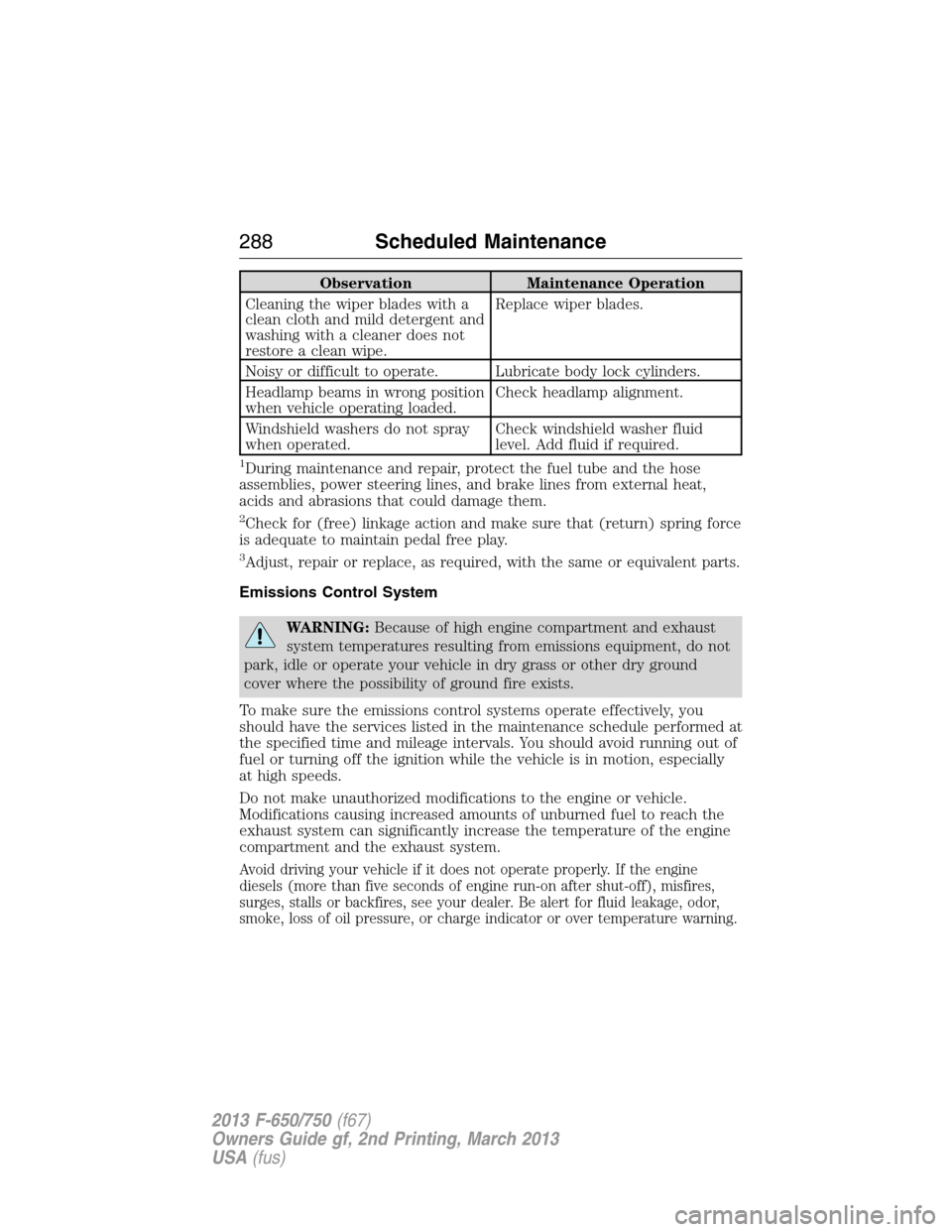
Observation Maintenance Operation
Cleaning the wiper blades with a
clean cloth and mild detergent and
washing with a cleaner does not
restore a clean wipe.Replace wiper blades.
Noisy or difficult to operate. Lubricate body lock cylinders.
Headlamp beams in wrong position
when vehicle operating loaded.Check headlamp alignment.
Windshield washers do not spray
when operated.Check windshield washer fluid
level. Add fluid if required.
1During maintenance and repair, protect the fuel tube and the hose
assemblies, power steering lines, and brake lines from external heat,
acids and abrasions that could damage them.
2Check for (free) linkage action and make sure that (return) spring force
is adequate to maintain pedal free play.
3Adjust, repair or replace, as required, with the same or equivalent parts.
Emissions Control System
WARNING:Because of high engine compartment and exhaust
system temperatures resulting from emissions equipment, do not
park, idle or operate your vehicle in dry grass or other dry ground
cover where the possibility of ground fire exists.
To make sure the emissions control systems operate effectively, you
should have the services listed in the maintenance schedule performed at
the specified time and mileage intervals. You should avoid running out of
fuel or turning off the ignition while the vehicle is in motion, especially
at high speeds.
Do not make unauthorized modifications to the engine or vehicle.
Modifications causing increased amounts of unburned fuel to reach the
exhaust system can significantly increase the temperature of the engine
compartment and the exhaust system.
Avoid driving your vehicle if it does not operate properly. If the engine
diesels (more than five seconds of engine run-on after shut-off), misfires,
surges, stalls or backfires, see your dealer. Be alert for fluid leakage, odor,
smoke, loss of oil pressure, or charge indicator or over temperature warning.
288Scheduled Maintenance
2013 F-650/750(f67)
Owners Guide gf, 2nd Printing, March 2013
USA(fus)
Page 290 of 378
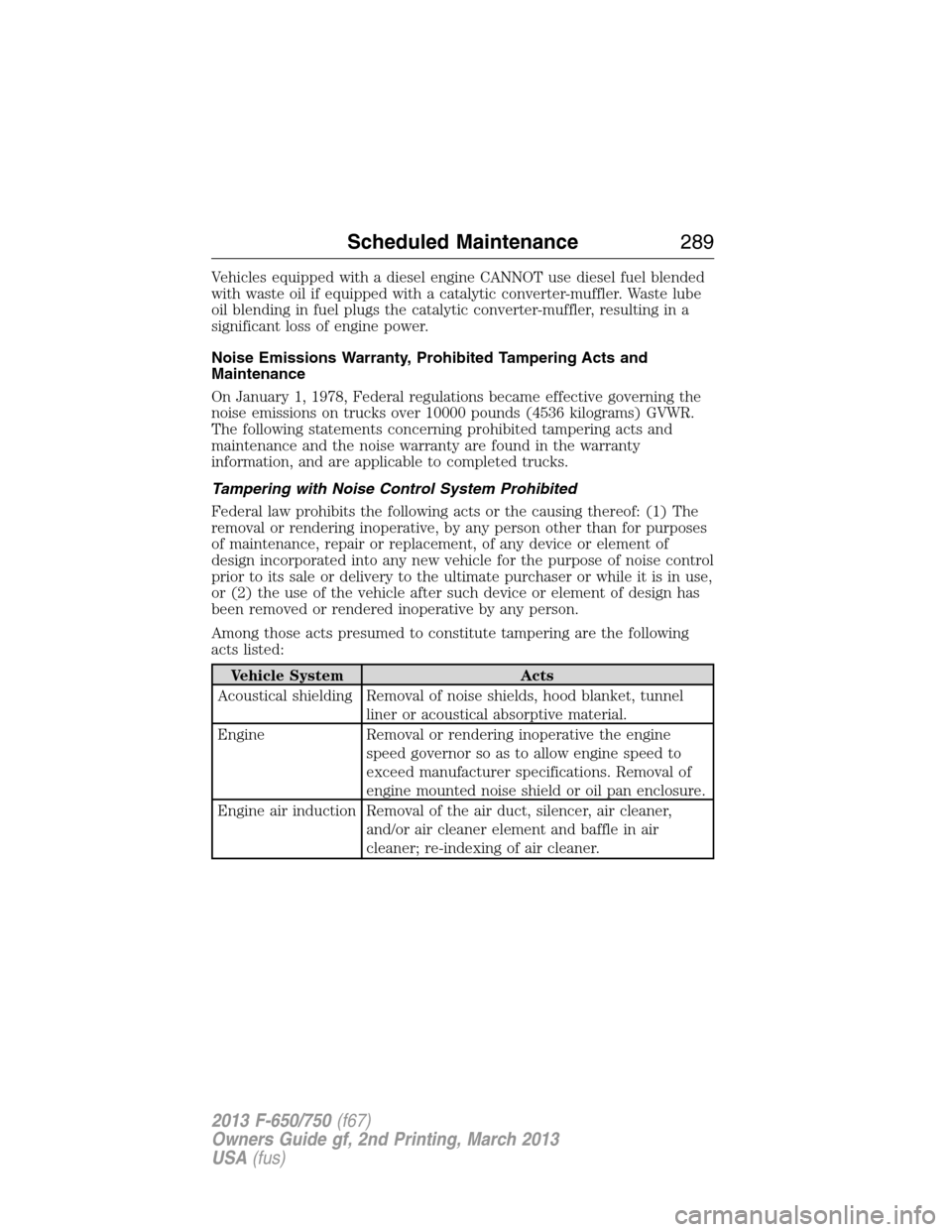
Vehicles equipped with a diesel engine CANNOT use diesel fuel blended
with waste oil if equipped with a catalytic converter-muffler. Waste lube
oil blending in fuel plugs the catalytic converter-muffler, resulting in a
significant loss of engine power.
Noise Emissions Warranty, Prohibited Tampering Acts and
Maintenance
On January 1, 1978, Federal regulations became effective governing the
noise emissions on trucks over 10000 pounds (4536 kilograms) GVWR.
The following statements concerning prohibited tampering acts and
maintenance and the noise warranty are found in the warranty
information, and are applicable to completed trucks.
Tampering with Noise Control System Prohibited
Federal law prohibits the following acts or the causing thereof: (1) The
removal or rendering inoperative, by any person other than for purposes
of maintenance, repair or replacement, of any device or element of
design incorporated into any new vehicle for the purpose of noise control
prior to its sale or delivery to the ultimate purchaser or while it is in use,
or (2) the use of the vehicle after such device or element of design has
been removed or rendered inoperative by any person.
Among those acts presumed to constitute tampering are the following
acts listed:
Vehicle System Acts
Acoustical shielding Removal of noise shields, hood blanket, tunnel
liner or acoustical absorptive material.
Engine Removal or rendering inoperative the engine
speed governor so as to allow engine speed to
exceed manufacturer specifications. Removal of
engine mounted noise shield or oil pan enclosure.
Engine air induction Removal of the air duct, silencer, air cleaner,
and/or air cleaner element and baffle in air
cleaner; re-indexing of air cleaner.
Scheduled Maintenance289
2013 F-650/750(f67)
Owners Guide gf, 2nd Printing, March 2013
USA(fus)